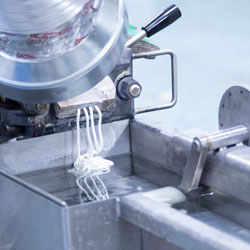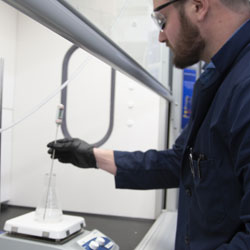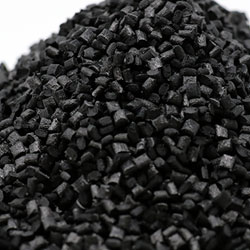Polymer Technologies
Continuous Architecture Modification
Continuous Architecture Modification (CAM) enables controlled molecular modification of condensation polymers through traditional processing methods to provide new value to existing polymers. CAM removes the need for polymerization of brand-new polymers by adjusting the backbone of standard materials to alter their properties, allowing them to meet the needs of even the most demanding applications. CAM is the perfect solution for a variety of applications from controlled manipulation of polymer properties to creation of ultra-high performance polymer composites.

Flow Control:
CAM offers precise rheological control to enable use of unique polymers in any processing technology. Though controlled chain scission, CAM can reduce molecular weight of condensation polymers while maintaining its polydispersity. By keeping polymer chain lengths uniform and not producing a large amount of very small molecules high viscosity resins with unique properties offered for extrusion can be modified for suitability in injection molding and even additive manufacturing without sacrificing their inherent properties.

Architecture Modification:
In addition to molecular weight control, CAM can be leveraged to change the actual architecture of a polymer. Using Continuous Architecture Modification, linear polymers transformed into branched, hyperbranched, or even dendritic macromolecules. By changing the architecture, properties of off-the-shelf materials can be drastically changed to increase toughness, improve melt strength, alter crystallization kinetics, and more. Architecture modification can also be used to compatibilize polymer blends and even to create copolymers of two or more components.

CAM Composites:
The CAM technology can be utilized to improve the interfacial adhesion between polymers and fillers in order to increase the mechanical performance of the resulting composite. By using CAM to covalently attach desired functional groups to the backbone of a polymer, linkages can be created between the matrix and desired reinforcement. CAM composites with glass or carbon fibers provide an average increase in strength and stiffness of 30% or more based on the fiber content. This provides the ability to use less fiber to achieve the same mechanical performance resulting induced cost in the case of composites with carbon fiber and reduced density in blends utilizing glass. CAM also makes is possible to create short fiber composites that have the performance of long fiber reinforced polymers making them less expensive and significantly easier to process. Additionally, Continuous Architecture Modification can be leveraged in particulate based composites to retain impact toughness and improve surface finish as well as enabling higher loadings of inorganic fillers to achieve high density composites or other high performing compounds.
Morphologically Optimized Resins
Lumas’ Morphologically Optimized Resins (MOR) technology is a revolutionary compatibilization and impact modification system designed to elevate the performance of polycarbonate blends. By controlling the blends microstructure, MOR additive allows for industry leading impact performance without sacrificing other critical mechanical properties like strength and stiffness. When applied to PC/ABS blends, MOR enables no-break notched Izod performance at room temperature and -40C impact performance in excess of polycarbonate and polycarbonate-polysiloxane copolymers at 23C. In addition to PC/ABS, MOR can provide similar performance in other critical PC blends such as PC/ASA, PC/AES, and PC/PBT as well as their functional compounds and composites.